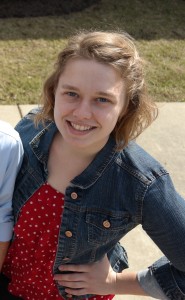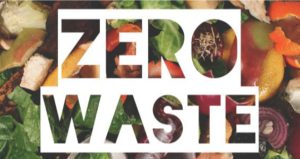One Lent, a couple of years ago, I vowed to give up trash. I chose Lent as a time to re-examine the amount of trash I was creating and tried to get that as close to “Zero” was possible. Choosing to embark on this journey during Lent was intentional—my faith informs my relationship with Creation. Sitting in my bedroom on Ash Wednesday, oily ash on my forehead, I found myself surrounded by things that would never turn to dust.
“From dust you were created, and to dust you shall return.”
While my faith informs my ecological passion and commitment to live simply, I was struggling to see this lived out in an intentional way in the church around me. I was inspired by a woman named Bea Johnson, who is the mother of a worldwide movement, called the “Zero Waste Lifestyle.”

The Zero Waste Lifestyle is about making as little trash as possible. Johnson and her family of four can fit a year’s worth of trash in a quart size jar. This moment is when we all gasp and wonder how when the average American produces about 4.4lbs of trash in a single day. Just think for a moment about all of the things that you have touched today whose final destination will be “away.” But where is away truly?
During Lent, I confessed my complicity within a consumeristic society. I confessed to using an item for thirty minutes (or even less) and tossing it into the trash can. I confessed that I had mindlessly tossed something “away” without considering the real consequences of where “away” might truly be. Most of our trash goes to landfills, which really should be known as “mega-fills” for their mammoth size. These mega-fills are usually in the backyard of the socioeconomic disadvantaged. In the Pacific Ocean, we have so much plastic trash swirling that we had to name this new region of the Sea: The Great Pacific Garbage Patch. The water and the sun break down plastic into little microplastics which are ingested by sea life. There are countless images of Albatross birds with stomachs full of plastic particles and sea turtles suffering from plastic straws and soda-can rings.
In Genesis 2, God makes it known that we like “every animal of the field and every bird of the air” are made of dust. We are all made from the same substance. That the creator God became embodied in the dust of Creation, to save Creation, suggests that this dust matters. My Anabaptist faith taught me to pay particular attention to the disadvantaged—to “the least of these.” When throwing my trash “away,” I was complicity throwing it into the backyards of my neighbors. It was disappearing from my sight, but re-appearing in the sight, smell, sound, and soul of others.
The Zero Waste Lifestyle promotes “Refuse, Reduce, Reuse, Recycle, Rot” and in that order. Refuse involves stopping the flow of waste from entering our homes, our lives. During Lent, I began to refuse “single-use disposable items” like the Starbucks coffee cup (in seasonal color), the plastic bag from the grocery store, the napkin and straw from the restaurant, the to-go container. Reduce means limiting our consumption and downsizing our possessions. The less
stuff we have—the less we must upkeep, and the less likely our possessions are to possess us. I downsized my closet and committed to only buying second-hand clothing. Reuse focuses on using quality items that will last. I brought my to-go container to restaurants and made sure to have a “Zero Waste Travel Kit” with me to help me avoid waste as I navigated the world. This kit included metal silverware, a cloth napkin, and a mason jar for a to-go cup. Recycle seems like it would be an important component in a Zero Waste Lifestyle, but there is a reason it’s at the end! Recycling of plastics is a closed-loop system because a #1 plastic bottle won’t become a #1 plastic bottle again, but a lesser plastic. So, I tried to avoid items packaged in plastic and opted for glass or cardboard which can be eternally recycled. Rot is the hopeful end to our waste. While a Zero Waste Lifestyle hopes to create minimal trash, it does produce things that need composting like food scraps and wooden items. This is God’s idea of filling the land.

I took areas of my house and my life and tried to find Zero Waste alternatives. In my bathroom, when my toothpaste in a tube ran out—I made my own from baking soda and coconut oil. I bought bars of soap without packaging, instead of facewash with “exfoliating” microplastics. In my kitchen, I tried to buy only fresh produce (instead of packaged) and purchased grains and beans in bulk bins where I could find them. I made all of my meals from scratch, and I learned how to make food items that might come in plastic: like tortillas and brown sugar. In my bedroom, I learned how to mend holey items and gave them a second life. For school, I submitted papers electronically and refused handouts in class when available online.
I did produce trash during my Zero Waste Lent because it was the beginning of a journey. I found that pursuing a Zero Waste Lifestyle has opened up simple living to me in a whole new way. It created physical and emotional space in my life to encounter the Holy in new ways. I was partnering with people in my community by bringing cloth bags or refusing a straw. I was inviting creativity into my life by finding sustainable alternatives to the plastic world that surrounded me. I had fewer clothes and mysteriously didn’t suffer from the “I have nothing to wear syndrome!” I let go of the items and things that were taking up space. Instead, I filled my moments with experiencing life and creativity, instead of mindlessly consuming. I washed dishes with friends at common meal and used the soil from my compost bin to start a garden in our backyard. Most importantly, I abandoned the idea that I am what I own and found myself resting in the mantra of being a child of God.
Pursuing a “Zero Waste Lifestyle” sounds like a daunting task, but there are small ways that we can challenge the systems which render God’s planet as inconsequential. Imagine if our churches, if faithful followers of Jesus led the way in modeling a sustainable life on the Earth. At the conclusion of Lent, we celebrate the resurrection hope—of what was dead becoming alive. As followers of Jesus, may we continue to live in resurrection hope—sharing God’s redemptive, resurrection power with the world one intentional action at a time.
 Katie Heishman is an MDiv student at Bethany Theological Seminary and co-Program Director at Brethren Woods Camp and Retreat Center with her husband, Tim. They live in the Shenandoah Valley of Virginia and attend Linville Creek Church of the Brethren.
Katie Heishman is an MDiv student at Bethany Theological Seminary and co-Program Director at Brethren Woods Camp and Retreat Center with her husband, Tim. They live in the Shenandoah Valley of Virginia and attend Linville Creek Church of the Brethren.
Photo Credits: Kaikoura Seafest; Katie Heishman


